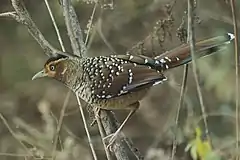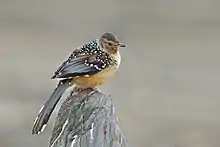| Ianthocincla | |||
| Gould, 1835[1] | |||
 Przedstawiciel rodzaju – sójkowiec oczkowany (I. ocellata) | |||
| Systematyka | |||
| Domena | |||
|---|---|---|---|
| Królestwo | |||
| Typ | |||
| Podtyp | |||
| Gromada | |||
| Podgromada | |||
| Infragromada | |||
| Rząd | |||
| Podrząd | |||
| Rodzina | |||
| Rodzaj |
Ianthocincla | ||
| Typ nomenklatoryczny | |||
|
Cinclosoma ocellatum Vigors, 1831 | |||
| Synonimy | |||
|
| |||
| Gatunki | |||
| |||

Sójkowiec duży (I. maxima)
Ianthocincla – rodzaj ptaków z rodziny pekińczyków (Leiothrichidae).
Zasięg występowania
Morfologia
Długość ciała 21–35,5 cm; masa ciała 43–136 g[7].
Systematyka
Etymologia
Ianthocincla (Janthocincla, Xanthocincla, Yantocincla, Zanthocincla): gr. ιονθος ionthos „młody zarost, puch”; nowołac. cinclus „drozd”, od gr. κιγκλος kinklos „niezidentyfikowany mały przybrzeżny ptak”[8].
Podział systematyczny
Takson wyodrębniony na podstawie badań filogenetycznych z Garrulax[9]. Do rodzaju należą następujące gatunki[10]:
- Ianthocincla sukatschewi – sójkowiec czarnoczelny
- Ianthocincla cineracea – sójkowiec wąsaty
- Ianthocincla rufogularis – sójkowiec rudobrody
- Ianthocincla konkakinhensis – sójkowiec wietnamski
- Ianthocincla ocellata – sójkowiec oczkowany
- Ianthocincla maxima – sójkowiec duży
- Ianthocincla lunulata – sójkowiec prążkowany
- Ianthocincla bieti – sójkowiec okularowy
Przypisy
- ↑ J. Gould. Characters of a New Genus of Merulidæ (Ianthocincla). „Proceedings of the Zoological Society of London”. 3, s. 47, 1835. (ang.).
- ↑ F.H. Troschel, J.P.E.F. Stein & A.F.A. Wiegmann. XII. Aves. „Archiv für Naturgeschichte”. 5 (2), s. 397, 1839. (niem.).
- ↑ T.C. Jerdon. Catalogue of the Birds of the Peninsula of India, arranged according to the modern system of Classification: with brief Notes on their Habits and Geographic Distribution, and description of new, doubtful and imperfectly described Species (Continued). „Madras Journal of Literature and Science”. 10, s. 255, 1839. (ang.).
- ↑ B.H. Hodgson: Catalogue of Nipalese Birds, collected between 1824 an 1844. W: J.E. Gray: The zoological miscellany: to be continued occasionally. London: Published by Treuttel, Wurtz and Co., G.B. Sowerby, W. Wood, 1844, s. 83. (ang.).
- ↑ A. David. Catalogue des oiseaux de Chine observes dans la partie septentrionale de l’empire (au nord du fleuve-bleu) de 1862 a 1870. „Nouvelles Archives du Muséum d’Histoire Naturelle”. 7, s. 6, 1871. (fr.).
- ↑ F. Gill, D. Donsker & P. Rasmussen (red.): IOC World Bird List (v11.2). [dostęp 2021-07-24]. (ang.).
- ↑ N. Collar & C. Robson: Family Timaliidae (Babblers). W: J. del Hoyo, A. Elliott & D.A. Christie: Handbook of the Birds of the World. Cz. 12: Picathartes to Tits and Chickadees. Barcelona: Lynx Edicions, 2007, s. 251–253. ISBN 84-96553-42-6. (ang.).
- ↑ James A. Jobling: The Key to Scientific Names. [w:] Birds of the World [on-line]. Cornell Lab of Ornithology, Ithaca, NY, USA, 2021. (ang.).
- ↑ A. Cibois, M. Gelang, P. Alström, E. Pasquet, J. Fjeldså, P.G.P. Ericson & U. Olsson. Comprehensive phylogeny of the laughingthrushes and allies (Aves, Leiothrichidae) and a proposal for a revised taxonomy. „Zoologica Scripta”. 47 (4), s. 428–440, 2018. DOI: 10.1111/zsc.12296. (ang.).
- ↑ Systematyka i nazwy polskie za: P. Mielczarek & M. Kuziemko: Rodzina: Leiothrichidae Swainson, 1831 - pekińczyki - Babblers, laughing-thrushes and allies (wersja: 2018-11-05). [w:] Kompletna lista ptaków świata [on-line]. Instytut Nauk o Środowisku Uniwersytetu Jagiellońskiego. [dostęp 2021-07-24].
This article is issued from Wikipedia. The text is licensed under Creative Commons - Attribution - Sharealike. Additional terms may apply for the media files.